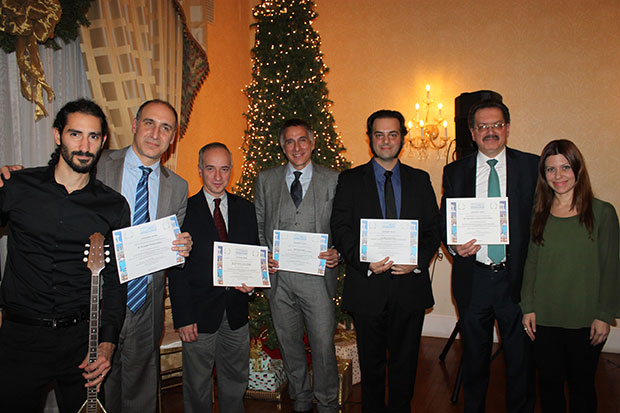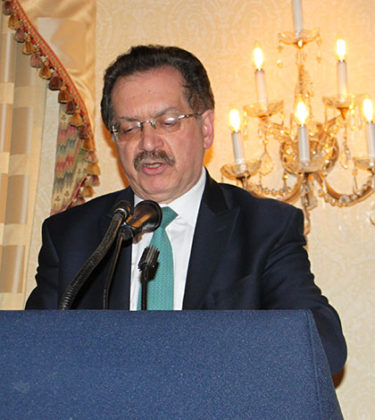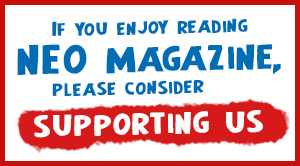Aghia Sophia: Times, Templates & Foundations from Byzantium to Present Day
by Chris Salboudis
EMBCA’s Lou Katsos and John Fotiadis organized an amazing panel discussion entitled “Aghia Sophia: It’s History, Architecture and Cultural Contributions” at the 3 West Club in New York City on December 13th. The discussions on the architectural and cultural legacy of this historic edifice and the live musical performances by featured guest Mike Risko Savvas of Porphyra were very well received by those assembled.

The panelists: Mike Risko Savvas (Musician & Professor), Alexander Billinis (Author, The Eagle has Two Faces), Dean Sirigos (Journalist), John Fotiadis (EMBCA VP, Architect), Vassilios Chrissochos (Choreographer, Composer, Director Porphyra), Lou Katsos (EMBCA President) and UNESCO Greece Representative Despina Afentouli
Lou Katsos opened the evening with an explanation of the mission and purpose of EMBCA’s Byzantium lecture series. EMBCA (the East Mediterranean Business Culture Alliance) is a New York-based organization of approximately 1,000 members established and directed by professionals and scholars from various fields to promote and support the East Mediterranean Community. EMBCA’s goals are to organize, promote and fund professional, educational and cultural programs and activities at the local and national levels. They are also open to collaborating with other organizations to help promote the growth and flourishing of our collective community. “This is just the first of several Byzantine-oriented events that EMBCA will have. We plan to host several other business and cultural events including activities in the food industry, shipping, and an event that will focus on the fall of Constantinople on May 29th.” When asked why the team at EMBCA identified Aghia Sophia as a keystone topic for this series of educational discussions, Lou explained, “Because the current history, especially with what’s going on now with the Turks… we’re faced with constant destabilization of the Hellenic nation – on our shores, in our space, we’ve faced very invasive elements thousands of times. This talk is meant to help counter the decision to turn Aghia Sophia – our space – back into a mosque, which goes against the recent past.”
“The dome of Aghia Sophia represents two things: It’s a Cosmos represented in concrete, like the Parthenon, and it’s a canopy, providing coverage of the sacred altar.” says John Fotiadis, VP of EMBCA. In terms of the unique architecture and the “Why?!?” behind the numerous conversions that Aghia Sophia has suffered over the centuries, John Fotiadis presented a thorough overview of the architectural marvel we are currently fighting to preserve, and transported the audience through a historical outline of the transformations from a basilica to a mosque to a museum. His presentation also highlighted the many other more modern structures around the world that were heavily influenced by the sound architecture and aesthetic of the original basilica.

EMBCA President Lou Katsos
The story of Byzantium – of the rich Hellenic culture cultivated in Medieval times through the brick and stone of architectural marvels like Aghia Sophia – is considered to be part of a longer philosophical and scientific legacy that can be traced back to the ancient Greeks and Romans. One of the featured panelists, Dean Sirigos, “The Voice” on many of the thought-provoking articles on Greek culture in several prominent publications both in the US and abroad, says he was honored to be a part of the event. When asked why Aghia Sophia is such a centripetal icon in Greek history and culture going back to the Byzantine Era, he says, “I called my contribution ‘Aghia Sophia: Neither an Accident nor a Miracle’ to point out that this magnificent building was the product of a civilization that is underappreciated. The Late Antique period, for all its artistic achievements in giving birth to Byzantine art, etc. is not given credit for its intellectual and technological dynamism, and Aghia Sophia is proof of that. It is such an amazing building that in later centuries it was believed that the design was miraculously revealed to the builders by God.” In his talk, Dean pointed out that the roots of several of the early modern discoveries and inventions could be traced back to the work of Aristotle through references from such scholars as John Philoponos, Isaac Newton, and even Galileo. The designers of this magnificent edifice were part of a very vibrant urban culture on the verge of multiple industrial and scientific breakthroughs before the crippling plague of the 6th century and the invasions of the 7th century wreaked havoc on the economic foundations of the Eastern Roman Empire.
His talk was full of anecdotes that informed and encouraged attendees to carry the torch for our history, our roots, and – quite literally in the case of Aghia Sophia – our foundations. “Regarding the Turkish government’s rumblings about turning Aghia Sophia from a museum into a mosque, I don’t believe they will do that – they make a lot of money from admissions – but the Greek-American community must be vigilant. We should support and be in touch with organizations like the American Hellenic Institute (AHI), the Coordinated Effort of Hellenes, AHEPA, the Hellenic American Leadership Council (HALC) and the Archons of the Ecumenical Patriarchate, which monitor cultural and religious freedom issues in Turkey.”
Alexander Billinis, author of the intriguing book The Eagle Has Two Faces: Journeys Through Byzantine Europe, discusses the visual and conceptual presence of a Byzantium in popular culture from the Silver Screen era to present day. His talk revealed that there is minimal representation – and what is available is crafted and distributed mainly through the vast network of the Turkish cinema industry. There is a visible absence of our community’s presence in films and in print; Alexander points to the fact that todays’ youth learn of ancient Greece and Rome in the majority of their classroom lectures and assigned readings, but little to nothing of the literature and culture of the Byzantine Era. The result is the possible warping of historical facts over time, the vilification of once heroes and the fading of values that were once held so close to heart. The solution he suggests is to bring the details of the Byzantine Era – both beauties and flaws – to the forefront of popular culture by building a presence in Hollywood and creating informative opportunities that will appeal to the masses as films like 300 have. The weight of this tasks will most likely fall on the shoulders of the vast Diaspora. “My own Diaspora origins derive from political and from economic factors….” Alexander mentions in his book, which then spans the vast regions of Eastern Europe including Serbia, Bulgaria, Romania, Italy and Greece (more specifically Athens and Pontos).

This call to action was beautifully tied in to the years of creative effort put forth by Vassilios Chrissochos, Director of Porphyra and Composer of the first-ever Grecian Rock Opera, which was wildly successful in both Carnegie Hall (2015) and Lincoln Center (2016) as well as an off-broadway theatre (2016). In a pre-panel interview, Vassilios, who has made an in-depth study of Hellenic and Byzantine history in addition to his progressive efforts in the music industry, says, “We are descendants of the Ancients, the Byzantine (Medieval) Greeks and the modern Greeks. It’s so important to learn and cherish your history and Orthodox Christian roots.” In line with this philosophy, Vassilios and the members of Porphyra, including Mike Risko Savvas, fuse the genres of classical Greek music and dance with modern rock to present the stories of Byzantium in a manner that will appeal to the masses and help educate today’s youth as well as the next generation. “The Porphyra project – the big project – integrates history, humor and the element of sexiness that make it attractive to our viewers and fans.”
The EMBSCO Directors, panelists and performers were honored by UNESCO Greece with Certificates of Merit for their effort to bring central issues regarding Greek culture and society to the forefront of 21st-Century discussions.
The call to action towards the preservation of our cultural legacy through the generation of music, literature, film and related educational projects and forums is clear. The heavy yolk of the responsibility falls to us, the members of the Diaspora, but through the continued efforts of institutions like EMBCA and its affiliates problems and major questions will be addressed as they were this evening, with a combination of knowledge, structure and creativity.











0 comments